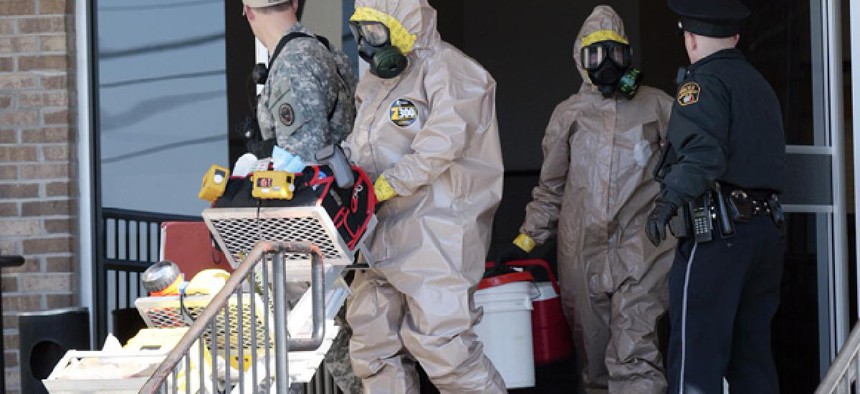Exposed to anthrax? In the future, your shirt could provide early warning.

A hazardous materials team is needed when powdered substances are thought to be anthrax often. Dave Martin/AP
The Pentagon wants clothing and paint that contain bio-warfare detectors.
The Pentagon wants clothing and industrial paint to be built with covert chemical warfare detectors, so that it can better anticipate threats such as anthrax, a defense solicitation reveals.
The Defense Threat Reduction Agency, the unit charged with reducing threats from biological warfare and nuclear weapons, is expressing “significant interest in materials that physically transform upon exposure to [chemical, biological, radiological and nuclear] agents, isotopes, and their precursors,” government documents show.
Officials envision detection technologies that generate certain signatures when exposed to anthrax spores, nuclear materials, medical isotopes, and chemical weapons. They want these reactions to occur covertly -- visually undetectable but apparent under infrared or black light, according to the call for small business proposals.
The technology could be used by the nuclear industry to protect employees from radioactive leaks. For instance, “a worker’s clothing could be treated with a material that transforms upon exposure,” reads the solicitation. Law enforcement could add the detection materials to industrial paint or construction materials.
The Pentagon has been eyeing ways to detect chemical warfare for years. It issued a call in 2010 for ways to map out chemical vapors across cities, with the goal of creating algorithms to help detect chemical weapons agents.
It’s tricky coming up with detection methods that don’t yield a lot of false positives. Scientists have encountered problems trying to create tests where substances in the environment don’t drown out the chemical signal from a biological weapon sample.
Scientists that have been experimenting with techniques include researchers at the Queen’s University in Belfast, who have been working on ways to shine laser beams onto a sample, with the aim of analyzing the light scattered to determine a chemical compound. The Australian Defense Department also has been testing hand-held devices that detect chemical and biological agents.
NEXT STORY: VA launches a healthcare data mapping project





